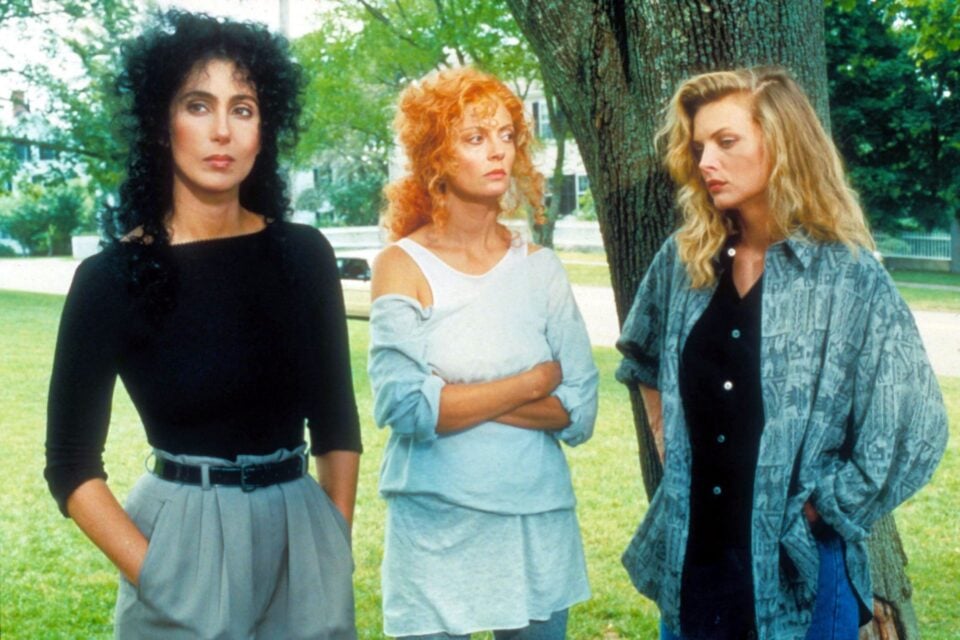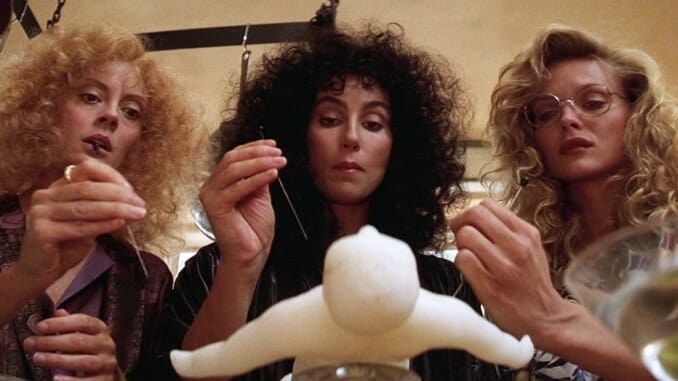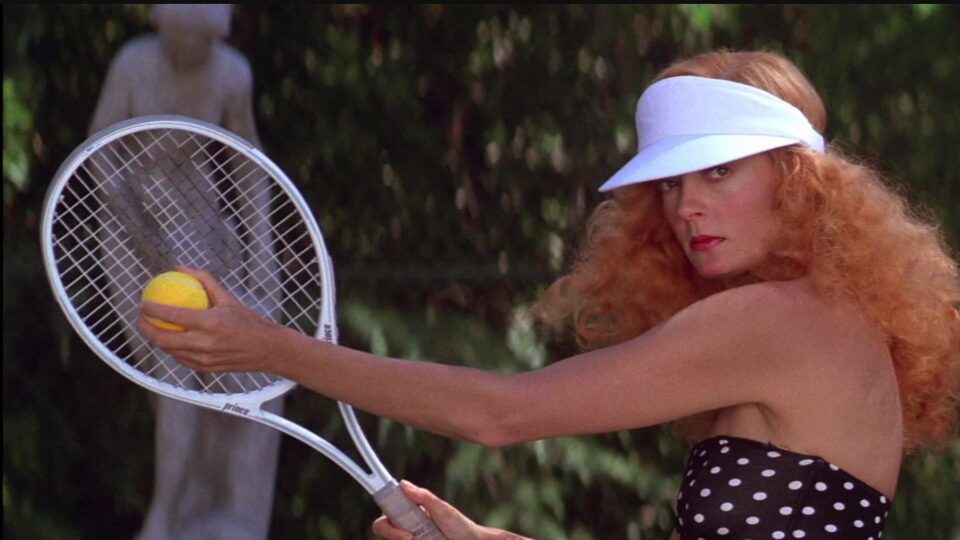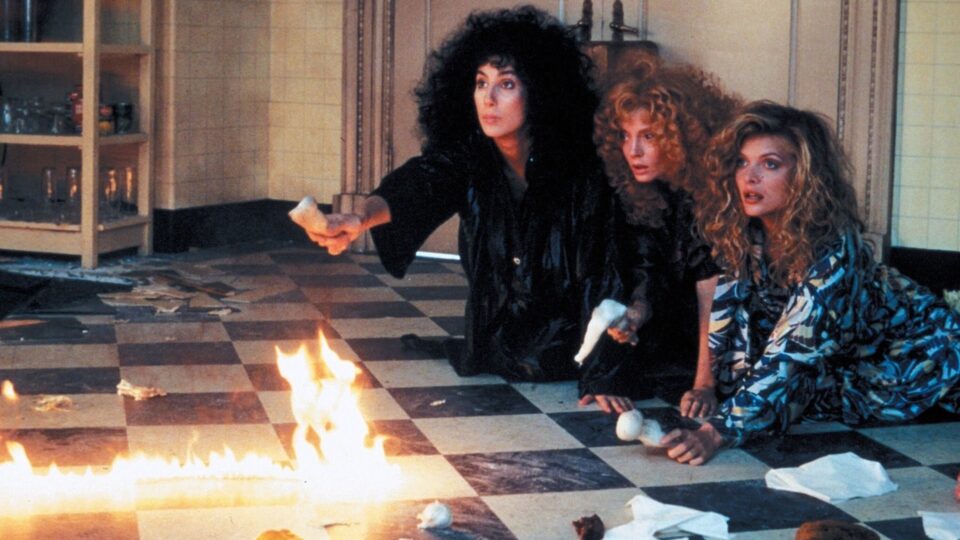John Williams Conjures Magic for ‘The Witches of Eastwick’

Welcome to Terror on the Turntable! In this monthly column, join Rachel Reeves as she explores the powerful and unholy alliance between horror films and their scores. Covering only scores released on vinyl, it’s a conversation about the intersection of music theory, composer style, film history, and the art of deep listening. So, light the candles, put on your headphones, and get ready to drop that needle. The sacred ritual of listening to music on wax is about to begin. This month, Rachel falls under the spell of John Williams’ enchanting score for The Witches of Eastwick.
When one’s credits include, but are not limited to, Jurassic Park, Star Wars, Indiana Jones, Jaws, Home Alone, E.T., JFK and Superman, it’s easy to see how a few projects might slip through the mainstream conversation cracks. Such is the case for the illustrious John Williams and his more than 65 years of composing for film. With so many incredible film scores that have become permanent fixtures in our shared cultural memories, some worthy titles rarely seem to get their due. So today, I’m conjuring up some words supporting 1987’s The Witches of Eastwick and its delightful, devilishly good score from John Williams.
Directed by George Miller (Mad Max), The Witches of Eastwick is an adaptation of John Updike’s novel of the same name. In the movie, Cher, Michelle Pfeiffer, and Susan Sarandon star as Alex, Sukie, and Jane, respectively—three single women living in conservative, small-town Rhode Island who dream of more. Without fully realizing their collective power, the women unintentionally manifest Daryl Van Horne.
Portrayed by Jack Nicholson, Van Horne blows into town and is—on paper—everything the women seek in a male partner. He’s charming, wealthy, intriguing, a good listener, and just handsome enough. However, initially unbeknownst to the women, he’s also manipulative, mischievous, arrogant and downright devilish. Before too long, the women see Van Horne for what he is and embrace their power to rid themselves and Eastwick of his dark presence.
Quickly following Mad Max Beyond Thunderdome, Miller traded in the Australian desert for the scenic Eastern Seaboard of the United States. As The Witches of Eastwick was Miller’s first real foray into Hollywood-style filmmaking, pursuing John Williams was probably not entirely Miller’s decision, but likely one he didn’t complain about either. I mean, it’s John Williams. With some of the film’s producers having previously worked with Steven Spielberg (a frequent Williams collaborator), Williams was likely always at the top of the potential composer list. Lucky for everyone, Williams signed on the dotted line.

Something Wicked This Way Comes
Along with dabbling in the dark and spooky, The Witches of Eastwick is an unabashedly humorous and clever movie. With its remarkable cast, impressive visual effects from Industrial Light and Magic, razor-sharp dialogue, and fantastic performances, it’s equal parts brilliant and fun. Williams’ score further reaffirms this delicate balance of humor and wit at every opportunity.
Effectively setting the tone for the film, “The Township of Eastwick” accompanies the opening credits as they descend from above into the picturesque East Coast town. Featuring a crisp, uplifting synth melody up front, the track soon expands with woodwinds and strings joining the party. Playful and light, the fiddle-like execution of the strings, in particular, impart a folk-dance feel to the moment very reminiscent of historic tunes. Not only does this choice help reinforce the rich setting, but it cheekily plays up the fiddle and violin’s long-rumored association with the devil or occasions that may invite the devil in.
At the same time, the music introduces us to two of our three leading women. Alex (Cher) lives on the water with her daughter and creates beautiful, voluptuous sculptures of the female form. Sukie (Pfeiffer) tends to her garden while doing her best to wrangle her six vibrant daughters. As piano, fresh woodwind, brass, and low voices join the musical conversation, the combination conveys their status as dynamic women living literally and figuratively outside societal norms. Subtlely mirroring and playing with history’s dark past of labeling such women “witches,” Williams immediately shows his cards as a true film-scoring master having an absolute blast with the material.

There is Danger Here
Continuing this thoughtful approach, Williams achieves something exceptional with “The Dance of the Witches.” This heavily thematic track is the core of the score, which fuels many subsequent musical moments in various intensities and incarnations. Lively, with just the right amount of darkness, it is a piece that one might easily mistake for a Danny Elfman/Tim Burton joint. It’s also one where fans of Williams’ Harry Potter scores may catch snippets of things to come. Although not typically known for his darker fare, Williams proves with this track that he took this assignment as seriously as any other.
Propulsive from the very beginning, robust and low minor thirds create a strong foundation. Cascading triplets from flutes layer on top, creating an enchanting rhythm. The rhythmic undercurrent grows and swells as harpsichord and woodwinds carry the melody. Alongside these elements, strategic percussion reinforces religious undertones. Employing a tarantella-like structure, Williams gives the music a sense of urgency, allowing anticipation and tension to build in equal measure.
While triplets inject specific energy into “The Dance of the Witches,” it’s hard to imagine that the three women at the heart of the story didn’t factor into this creative decision as well. The same goes for Daryl and the use of minor thirds throughout the score. Summoned and manifested from the women’s collective musings, Daryl Van Horne is a part of the women and owes his presence in Eastwick entirely to them. While he appears to be everything they desire, devious motivations simmer beneath the surface. Intrinsically linked, Williams mirrors and captures this dynamic and incorporates it into the very soul of the score.

Just Your Average, Horny Little Devil
Before the women get completely wise to Daryl’s dastardly plans, they discover a new sense of freedom and strength from living authentically and worrying less about how others in Eastwick may perceive them and their unique arrangement. Breaking free from the “medieval morality” that plagues many of the town’s residents, the women and the music accompanying them evolve.
Perhaps the best and most beautiful aural example appears in “The Tennis Game.” Playful piano, vivacious strings, and exuberant rhythms convey the sheer joy the women are experiencing in this new reality. While that feeling proves to be short-lived, the experience is nonetheless delightful.
As Daryl’s new dude smell wears off, the women become suspicious of his motivations and knack for gaslighting. Taking control of the situation, the women break off their relationship with Daryl and focus on themselves. As one might expect, Daryl does not take this show of strength from the women or their rejection well. However, it gives us, as the audience, some fantastic scoring and music.
While previous versions of “Daryl’s Theme” in tracks like “The Seduction of Alex,” “Have Another Cherry,” or “Daryl’s Secrets” play up the more seductive and charming qualities of his personality in an almost James Bond-like fashion, this facade begins to crack as the women gain strength and lose patience. In “Daryl Rejected,” the once confident melody now feels plaintive and forlorn when played on piano and oboe. Combined with gasp-like descending two-note elements, Williams effectively telegraphs Daryl’s weakening emotional grasp on the women.
Finally, a dramatic showdown occurs between Daryl, Sukie, Alex, and Jane. Daryl races towards his mansion and transforms into a hideous, monster-like creature in a last-ditch effort to overpower the women and the spell they have cast upon him. Williams pulls out all the stops for this dramatic, culminating scene with “The Destruction of Daryl.”
Authoritative brass and percussion accentuate the danger while swirls of strings, woodwinds, and organs sell the chaos and severity of the situation. Bold and bombastic, the track plays like some of Williams’ best action and fantasy sequences and then…poof. Just like Daryl himself, the track fittingly roars in like a lion and goes out like a lamb.

A Woman of Obvious Power
It would be easy to write off The Witches of Eastwick as a slightly dated take on feminism with some incredible outfits, hair, and performances. Even though these last three things still hold up, pigeonholing the film as 80s-era “shoulder-pad feminism” doesn’t give it its proper due. Under the wigs, beauty, and Nicholson of it all, The Witches of Eastwick still stands as an intriguing examination of feminism, female empowerment, and the complexity of what that means in an innately patriarchal society.
Similarly, when stacked up against some of Williams’ many iconic scores and contributions to film, it would be easy to overlook The Witches of Eastwick or label it as a lesser piece of work. However, to do so would be a terrible mistake. Bursting with rich themes, nerdy musical wit, and irresistible energy, John Williams’ score for this kooky film captures his sense of humor and joyful passion for film composing in a truly distinctive way. Even The Academy recognized the brilliance of his work despite the film’s moderate box office success and lukewarm critical reception, nominating it for Best Original Score in 1988.
So set aside that Jaws record and press pause on that Jurassic Park playlist—just for a moment. This spooky season, I encourage you to fall under the spell of The Witches of Eastwick. A truly magical musical experience from beginning to end, the time has come to give this undervalued Williams work its much-deserved moment in the spotlight and on your turntable.
Crate Digging
In conjunction with the film’s initial release, Warner Bros. Records released three versions of the soundtrack (how appropriate): CD, LP, and cassette. Probably because it was 1987, the CD version went out of print pretty quickly but has since been reissued a couple of times. While the vinyl version hasn’t gotten the same reissue treatment yet, there’s absolutely nothing wrong with the original release.
Containing 14 fabulous tracks, this simple, standard release is totally worth snagging if one should happen to come across it. Not a particularly rare release, the odds are pretty good that will happen at some point. With decent copies typically selling for around $10, this is definitely one record worth adding to your collection.
Categorized:Editorials Terror On The Turntable
